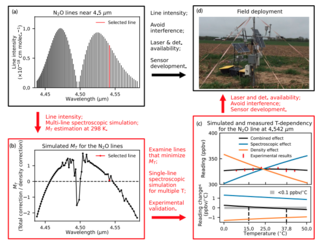A new open-path eddy covariance method for nitrous oxide and other trace gases that minimizes temperature corrections
D. Pan et al. "A new open-path eddy covariance method for nitrous oxide and other trace gases that minimizes temperature corrections" Global Change Biology 28 (2021) [DOI:10.1111/gcb.15986]
Low-power, open-path gas sensors enable eddy covariance (EC) flux measurements in remote areas without line power. However, open-path flux measurements are sensitive to fluctuations in air temperature, pressure, and humidity. Laser-based, open-path sensors with the needed sensitivity for trace gases like methane (CH4) and nitrous oxide (N2O) are impacted by additional spectroscopic effects. Corrections for these effects, especially those related to temperature fluctuations, often exceed the flux of gases, leading to large uncertainties in the associated fluxes. For example, the density and spectroscopic corrections arising from temperature fluctuations can be one or two orders of magnitude greater than background N2O fluxes. Consequently, measuring background fluxes with laser-based, open-path sensors is extremely challenging, particularly for N2O and gases with similar high-precision requirements. We demonstrate a new laser-based, open-path N2O sensor and a general approach applicable to other gases that minimizes temperature-related corrections for EC flux measurements. The method identifies absorption lines with spectroscopic effects in the opposite direction of density effects from temperature and, thus, density and spectroscopic effects nearly cancel one another. The new open-path N2O sensor was tested at a corn (Zea mays L.) field in Southwestern Michigan, United States. The sensor had an optimal precision of 0.1 ppbv at 10 Hz and power consumption of 50 W. Field trials showed that temperature-related corrections were 6% of density corrections, reducing EC random errors by 20-fold compared to previously examined lines. Measured open-path N2O EC fluxes showed excellent agreement with those made with static chambers (m = 1.0 ± 0.3; r2 = .96). More generally, we identified absorption lines for CO2 and CH4 flux measurements that can reduce the temperature-related corrections by 10–100 times compared to existing open-path sensors. The proposed method provides a new direction for future open-path sensors, facilitating the expansion of accurate EC flux measurements.
The spectroscopic results and 30-min flux data, and the 10-Hz raw eddy covariance that support the findings of this study are openly available in DataSpace at Princeton University.
